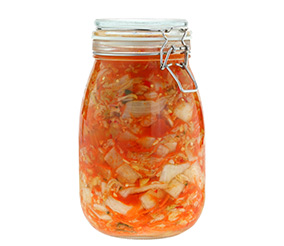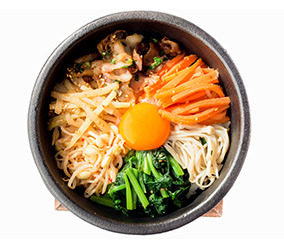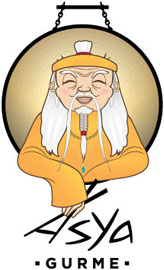Cuisines
(Korean)

Kimchi

Bibimbap
Korean Cuisine is high in nutrition and law in calorific value.
This is to say it is a thoroughly healthy kitchen as well as delicious. This cuisine mainly consists of grains and vegetables although meat takes an equallly substantial part. Vegetables are consumed raw or very little cooked and this helps decreasing body fat. Korea is known to be a part of the “Far East Cuisine” but remains very authentic with its unique spices and hot dishes for the plate.
Developing a Unique Cuisine
A new era begins with cayenne pepper entering to Korean Cuisine. It has taken a long time for Korea to establish its cuisine take its present shape. The process backdates 18th and 19th centuries and Korea invents its own cuisine.
In the South regions we observe food is saltier, more spicy and intensely seasoned than the North. In the traditional manner all the dishes are presented at the same time on the banquette. Sequencing is not to be expected.
Korea’s Favorites
In Korea the most popular ingredients are hot cayenne pepper, garlic, onion, soy sauce, soybean paste, sesame seeds, sesame oil and ginger.
Soup, rice, noodle, tofu, veggies, poultry, and meat are consumed very frequenty. Seafood and fish are also very favorite. Soup always have a special meaning in this country. People consume soup instead of drinking water. This is not only because of sanitary concerns but for the reasons based on cultural instincts.
‘Kimchi’, some kind of pickled cabbage is a side dish and also a main ingredient to a number recipes is considered very healthy, and digestive, and prevents diseases.
‘Banchan’ is the name for some side dishes and can be accepted as a ‘Turkish Meze’ or assorted appetizer. Banchans are very fundemental to Korean. These are served usually beside the steamed rice, in groups of ‘three’ or ‘twelve’.
‘Gamja Jorim’ (caramelized potatoes), ‘Oijangaji’ (pickled cucumbers), ‘Habok Jeon’ (Korean style deep fried patties) are some of them.
The food is prepared in different cooking manners such as grilling, frying, braising, stir frying and boiling. Their traditional food Kimchi is mainly pickled cabbage prepared in brine with Chinese cabbage, garlic, cayenne pepper and shallots and is very very spicy. Could also be prepared with cucumber and white radish as well as the cabbage. Kimchi is served often as a side dish with almost every food and used as an ingredient when cooking.
Table Set Up and Chopsticks
According to the traditional table set up, the rice is placed always on the left and the soup is served on the right. The spoon is placed on the right hand side of the soup bowl followed by the sticks next to it.
Korean chopsticks are called ‘Jeotgarak’. Unlike the Chinese and the Japanese who prefer to use natural materals to produce the sticks, Korean choose to use stainless steel. Since the steel has a slippery surface to grab the food, the bottom parts of the sticks are indented.
Preferring metal for the sticks has an old story based on traditions. In the ancient times the sticks for the kings or feudal lords were made of pure silver so that if the food was poisened there would be a chance of noticing it by the color shift. Jeotgaraks in those days were made of copper and brass as well as silver. They are much shorter then those of Chinese
and Japanese and less easy to eat with. The big pieces are previously cut into smaller by using a knife or scissors. Koreans use the spoon to eat the rice unlike their neighboors.
2000 Years Old Tea
Korean Tea Tradition has a history of 2000 years and is a reflection of Chinese and Budhist traditons. The most popular one is the Ginseng tea along with fruit teas, green tea and the like. Ginseng tea is served with honey, dried date, pistachio and dried ginseng. The red ginseng which grows only in South Korea is known to be a valuable supplement for boosting the immune system.
“Mat-itkae Duseyo” Enjoy your meal!

